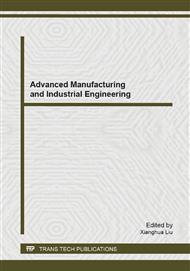p.432
p.437
p.441
p.447
p.453
p.459
p.464
p.468
p.472
Selection Algorithm of Developing New Products in Complex Environmental Constraints
Abstract:
This paper focused on selecting and developing the optimal new products in the environment of complex constraints. Selection models of new products development plans in the complex environmental constraints have been established. The models were designed by designing five variables, defining the four basic model’s initialization and analyzing variable structures of models. Based on the model and the actual problems, the optimal selection algorithm models of new product development’s plan in the complex environmental constraints have been designed. First of all, new product’s evaluation was evaluated by using the environmental factors to calculate the weight of related factors in this environment. Secondly, the data’s table of algorithm and the iterative process were designed. Finally, the optimal new product by iterative algorithm was employed to prove the optimal solution of in the algorithm. The model and algorithm in the specific implementation process has good flexibility, high efficiency and optimality.
Info:
Periodical:
Pages:
453-458
Citation:
Online since:
August 2014
Authors:
Price:
Сopyright:
© 2014 Trans Tech Publications Ltd. All Rights Reserved
Share:
Citation:


